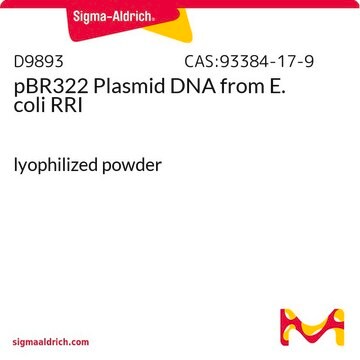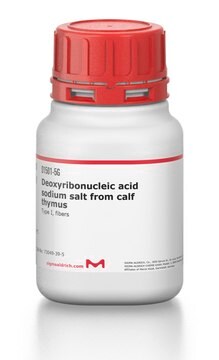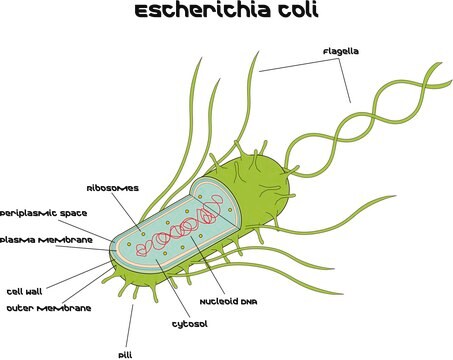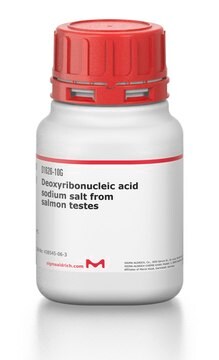D4904
pBR322 Plasmid DNA from E. coli RRI
buffered aqueous solution
Faça loginpara ver os preços organizacionais e de contrato
About This Item
Número CAS:
Número CE:
Número MDL:
Código UNSPSC:
12352200
eCl@ss:
32160414
NACRES:
NA.51
Produtos recomendados
recombinante
expressed in E. coli
Nível de qualidade
grau
Molecular Biology
for molecular biology
Formulário
buffered aqueous solution
peso molecular
2.9 MDa
4363 bp
Origem de replicação
BR322
Seleção
ampicillin
Condições de expedição
dry ice
temperatura de armazenamento
−20°C
Procurando produtos similares? Visita Guia de comparação de produtos
Descrição geral
Plasmid pBR322 was one of the first multipurpose cloning vectors constructed for use in E. coli. This plasmid is derived from the ColE1-type plasmid pMB1 and shares the same type of replication mechanism and controls as ColE1 and relatives. Plasmid pBR322 confers resistance to ampicillin and tetracycline. The plasmid sequence has been published.
The plasmid has unique restriction sites within the gene for ampicillin resistance (Pst I, Pvu I, and Sca I), within the gene for tetracycline resistance (BamH I, BspM I, EcoR V, Nhe I, Nru I, Sal I, Sph I, and Xma III), and elsewhere (Aat II, Ava I, Bal I, Bsm I, BspM II, Cla I, EcoR I, Hind III, Nde I, Pvu II, Ssp I, Sty I, and Tth111 I).
The plasmid has unique restriction sites within the gene for ampicillin resistance (Pst I, Pvu I, and Sca I), within the gene for tetracycline resistance (BamH I, BspM I, EcoR V, Nhe I, Nru I, Sal I, Sph I, and Xma III), and elsewhere (Aat II, Ava I, Bal I, Bsm I, BspM II, Cla I, EcoR I, Hind III, Nde I, Pvu II, Ssp I, Sty I, and Tth111 I).
Especificidade
Unique Sites: Within the gene for ampicillin resistance: Pst I, Pvu I, Sca I; Within the gene for tetracycline resistance: BamH I, BspM I, EcoR V, Nhe I, Nru I, Sal I, Sph I, Xma III; other unique sites: Aat II, Ava I, Bal I, Bsm I, BspM II, Cla I, EcoR I, Hind III, Nde I, Pvu II, Ssp I, Sty I, Tth111 I.
Aplicação
Plasmid pBR322 was one of the first multipurpose cloning vectors constructed for use in Escherichia coli. This plasmid and derivatives have been used for a number of purposes including cloning, selection and expression of recombinant molecules, construction of shuttle vectors and vectors for nucleotide sequencing, studies of elements involved in gene expression, as plasmid DNA standards, and as a model system for studies on prokaryotic plasmid replication.
pBR322 Plasmid DNA from E. coli RRI has been used to study about ferrous ion-induced strand breaks in the plasmid pBR322 are mediated through hydrogen peroxide.
Ações bioquímicas/fisiológicas
One of the most commonly used cloning vectors, pBR322, confers resistance to ampicillin and tetracycline. The DNA sequence of the entire plasmid has been published.
This plasmid is derived from the ColE1-type plasmid pMB1 and shares the same type of replication mechanism and controls as ColE1 and relatives.
Componentes
DNA is provided in a solution of 10 mM Tris-HCl (pH 8.0) with 1 mM EDTA.
Outras notas
Accession number: J01749
produto relacionado
Nº do produto
Descrição
Preços
Código de classe de armazenamento
11 - Combustible Solids
Classe de risco de água (WGK)
WGK 3
Ponto de fulgor (°F)
Not applicable
Ponto de fulgor (°C)
Not applicable
Equipamento de proteção individual
Eyeshields, Gloves, type N95 (US)
Escolha uma das versões mais recentes:
Já possui este produto?
Encontre a documentação dos produtos que você adquiriu recentemente na biblioteca de documentos.
Jörg Flemmig et al.
European biophysics journal : EBJ, 36(4-5), 377-384 (2006-10-19)
Ferrous ion-induced generation of single and multiple strand breaks in the DNA plasmid pBR322 induces the formation of two new plasmid forms with altered electrophoretic mobility. The yield of these plasmid forms, the circular relaxed and the linear forms, depended
Ferrous ion-induced strand breaks in the DNA plasmid pBR322 are not mediated by hydrogen peroxide
Flemmig J and Arnhold J
European Biophysics Journal, 36(4-5), 377-384 (2007)
Charles J Addison et al.
BioTechniques, 37(3), 376-378 (2004-10-09)
Transformation of Escherichia coli plays an important role in recombinant DNA technology. Most current transformation protocols require that the cells be treated to attain a particular physiological state known as "competence," and this makes transformation procedures lengthy and arduous. Here
Nossa equipe de cientistas tem experiência em todas as áreas de pesquisa, incluindo Life Sciences, ciência de materiais, síntese química, cromatografia, química analítica e muitas outras.
Entre em contato com a assistência técnica








